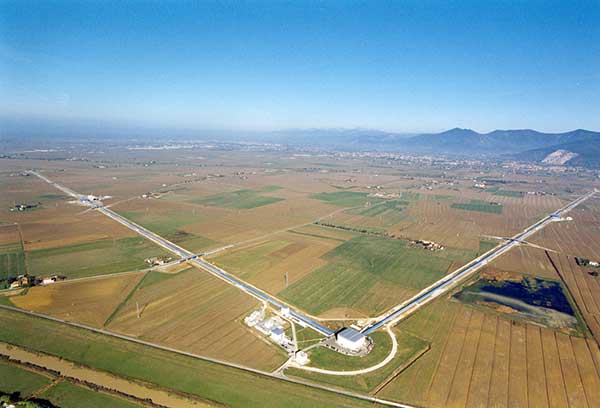With data from a third detector, researchers can better localize source of waves
By David Voss
On September 27, researchers from the Advanced Laser Interferometer Gravitational Wave Observatory (LIGO) and the Advanced Virgo Detector announced their joint detection of a gravitational wave signal from the coalescence of two black holes. The observation by three detectors (two from LIGO and the Virgo detector) allows the teams to improve their ability to identify where in the sky the waves are coming from. The announcement was made at a meeting of the G7 science ministers in Turin, Italy, and a paper describing the detection has been accepted for publication by Physical Review Letters.
The signal, which was observed on August 14, 2017, comes from a merger of a black hole 30.5 times the mass of the sun with another black hole 25.3 times the mass of the sun. The event occurred 540 megaparsecs from Earth, or about 1.8 billion light years away. Because the gravitational wave detection network involves three detectors, the researchers have been able to narrow down the location of the signal source by a factor of around 20 compared with LIGO’s previous detections.

Aerial view of the Virgo interferometer in Cascina, Italy
Each of these three detectors, LIGO’s two in Hanford, Washington and Livingston, Louisiana, and Virgo’s in Pisa, Italy, recorded the characteristic “chirp” signal of the black holes circling each other, then speeding up and merging. By comparing the waves’ arrival time at each detector, the researchers were able to improve the determination of the source direction. Previous detections by LIGO involved two detectors, which meant that the mergers could be identified only as lying somewhere in large portions of the sky.
"This signal has been traveling for almost 2 billion years towards Earth," said Jo van den Brand of Vrije Universiteit Amsterdam, spokesperson for the Virgo collaboration. "The signal was first detected by the LIGO detector in Louisiana, then 8 milliseconds later by the LIGO detector in Hanford, then 6 milliseconds after that, by the Virgo detector."
Brand said that this heralds a new era of "multi-messenger" gravitational wave astronomy. "With this triangulation, we can locate the source that is emitting these gravitational waves, and this is important because we expect that many such merger events emit other messengers, such as light, x-rays, radio waves, neutrinos, or other sub-atomic particles. These can be studied by both astronomers and astroparticle scientists."
In addition to better localizing the gravitational wave source, the participation of Virgo means that the polarization of the waves can be studied. Like other kinds of waves, gravitational waves oscillate in specific directions. Both of LIGO’s detectors are oriented in similar ways, so they were unable to sense the oscillation direction. Virgo is oriented in a way complementary to LIGO, so analysis of signals from the three detectors can reveal information about the polarization. With this information, even more stringent tests of general relativity should become possible.
"We were really eager that Virgo join us in this endeavor," said LIGO spokesperson David Shoemaker of MIT. "This information that comes from position is an amazing addition. We can use this information from pointing to give to our traditional astronomy colleagues [who use] telescopes on the ground and satellites, so that we can do this next step of multi-messenger astrophysics." He added, "The future is incredibly bright for the Virgo-LIGO network."
©1995 - 2024, AMERICAN PHYSICAL SOCIETY
APS encourages the redistribution of the materials included in this newspaper provided that attribution to the source is noted and the materials are not truncated or changed.
Editor: David Voss
Contributing Correspondent: Alaina G. Levine
Publication Designer and Production: Nancy Bennett-Karasik

